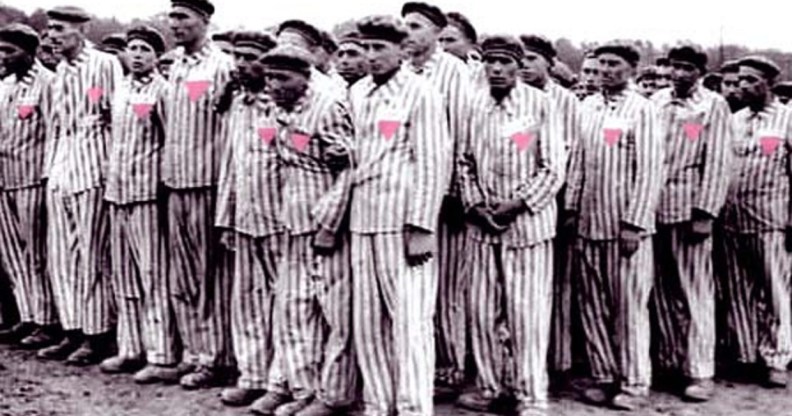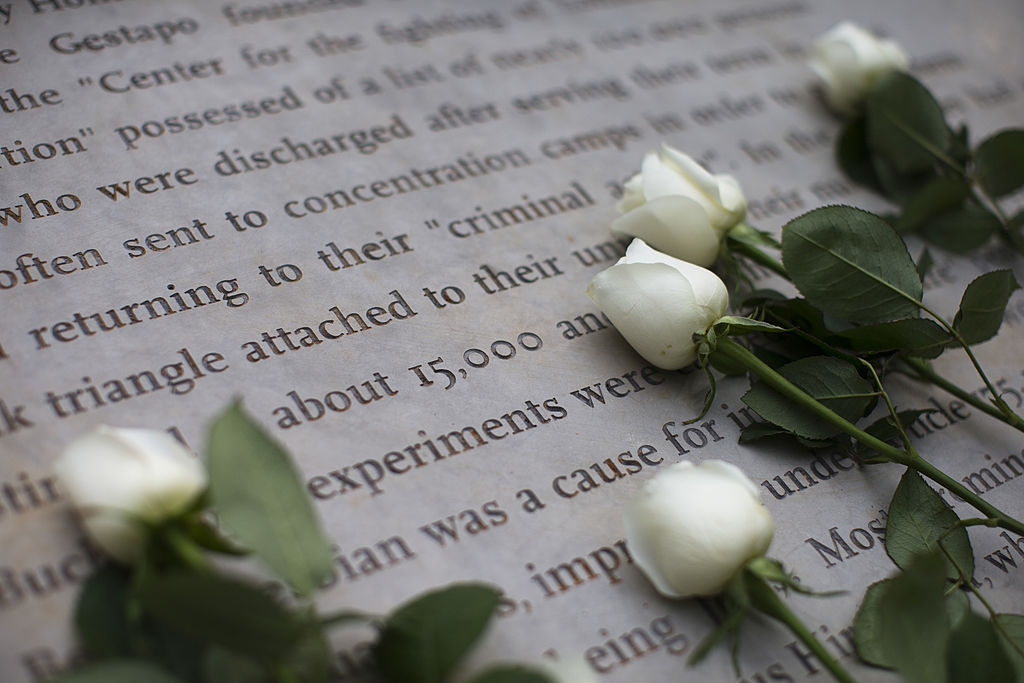Why the heinous crimes committed by the Nazis against thousands of queer people must never, ever be forgotten

Thousands of LGBTQ+ people were killed at the hands of the Nazis.
Thousands of LGBTQ+ people were killed at the hands of the Nazis.
On Holocaust Memorial Day 2021, we remember the victims, LGBT+ and otherwise, murdered by Nazis, and explore the significance of the pink triangle.
On Wednesday (27 January), 76 years after the Auschwitz concentration camp was liberated, buildings around Britain will be lit in purple, with those who are able to encouraged to light a candle in their window at 8pm GMT to remember those murdered simply because of who they were.
Every year on Holocaust Memorial Day, the world honours the millions of people who lost their lives during the Holocaust (as well as those who died under Nazi persecution and in subsequent genocides, such as those in Cambodia, Rwanda, Bosnia and Darfur).
Up to 17 million people were exterminated under the Nazi regime, with six million Jews included in that number.
The Holocaust was, at its core, a wide-scale and violent persecution of minority groups – and LGBT+ people were not exempt. Between 1933 and 1945, an estimated 100,000 men were arrested for homosexuality in Nazi Germany. Some 50,000 were sentenced for their “crimes” and an estimated 5,000-15,000 gay men were sent to concentration camps.
Sociologist Rüdiger Lautmann has estimated that up to 60 per cent of gay men incarcerated in concentration camps died during their imprisonment. But these figures only account for those who were persecuted directly for their sexuality. Among the millions of people killed in the Holocaust, there were undoubtedly many more LGBT+ people who kept their sexual and gender identities a secret as they went to their deaths.
The world today is a very different place, but the threat of violence is never too far away for minority groups. Hate crimes have surged across the world, including in the UK and the United States. Homophobic hate crimes have more than doubled in the UK in the most recent five-year period, with transphobic hate crimes quadrupling between 2014-15 and 2019-20. There were more than 6,800 hate crimes defined by religion in 2019-20 (a slight fall from the year prior), with antisemitism remaining pervasive.
In the United States, LGBT+ people, Jewish people and Black people are the most targeted groups. Jewish people in the US suffered more antisemitic attacks in 2019 than in any other year since the Anti-Defamation League began collecting records sine 40 years ago. The 2,107 incidents recorded marked a 12 per cent rise from 2018, which had been the worst on record previously.
These figures serve as a reminder that – while the Holocaust is part of our history – the lingering hatred of anybody seen as “different” is always ready to rear its head.
Holocaust Memorial Day: The Nazis immediately started targeting minority groups when they seized power in 1933.
When Adolf Hitler and his Nazi Party seized power in Germany in July 1933, the dictatorship moved to persecute and murder minority groups, including Jews, LGBT+ people, the Romani people, and political prisoners.
Beginning in 1933, the Nazis built a network of concentration camps throughout Germany, where “undesirable” groups were detained, including Jewish people and gay men.
Those “undesirables” often had their uniforms branded in concentration camps so officers knew what kind of person they were dealing with. Many gay people had their uniforms branded with an upside-down pink triangle. The symbol set them apart as sexually deviant, with paedophiles and rapists given the same mark.
Like other prisoners, those who wore the pink triangle were brutalised in ways that most people today cannot even begin to comprehend. Gay men were subjected to torture, including forced sodomy using wood, and many were experimented on. The Nazis also implemented a form of conversion therapy, whereby gay men were forced to sleep with female sex slaves.

Memorial in Tel Aviv for lesbian, gay, bisexual, and transgender victims of the Holocaust (Uriel Sinai/Getty)
Charting the history of other members of the LGBT+ community in the Holocaust is more challenging as they were not given their own distinct categories. Lesbians were sometimes made to wear a black triangle to denote that they were “asocial”, according to Benno Gammerl, a lecturer in Queer History at Goldsmiths, University of London.
There was no solidarity for the homosexual prisoners; they belonged to the lowest caste.
Meanwhile, trans people were generally lumped in under the same category as homosexuals under the Nazi regime, meaning many also wore the pink triangle. There is evidence that trans people, like gay people, were specifically targeted. On November 11, 1933, the Hamburg City Administration asked the head of police to “pay special attention to transvestites” and to “deliver them to the concentration camps”.
The end of the Second World War did not spell the end of the persecution of gay and bisexual men.
Unfortunately, when the allies liberated the concentration camps, many of the gay people who were imprisoned were not set free. Instead they were transferred to prisons, then under the control of the Allied forces. Same-sex sexual activity between men remained illegal in East and West Germany until 1968 and 1969 respectively.
Because homosexuality was still seen as a taboo topic for several decades after the end of the Holocaust, there are limited first-person accounts from queer survivors. One account, from Pierre Seel, who survived the Schirmeck-Vorbrück concentration camp near Strasbourg, recalled the trauma of watching his 18-year-old lover stripped by SS guards and mauled to death by German Shepherd dogs. Seel died in 2005.
“There was no solidarity for the homosexual prisoners; they belonged to the lowest caste,” Seel wrote in his 1995 book I, Pierre Seel, Deported Homosexual: A Memoir of Nazi Terror.
The pink triangle has been reclaimed by LGBT+ activists as a symbol of liberation and a reminder of the past.
While the pink triangle originated as a symbol of sexual deviancy, it has since been reclaimed as a powerful symbol by LGBT+ people across the world. In the 1970s, with the dawn of the modern gay liberation movement, activists took the upside-down pink triangle and turned it the right way around to use it as a sign of their own difference – and the need for that difference to be accepted, embraced and understood.
In 1972, the first autobiography of a gay concentration camp survivor was published. The Men with the Pink Triangle told the story of Josef Kohout and shone a light on the largely untold treatment of queer people in the Holocaust. The following year, Germany’s first gay rights organisation, Homosexuelle Aktion Westberlin (HAW) reclaimed the pink triangle as a symbol of liberation.
One of the organisation’s founding members, Peter Hedenström, said in 2014 that the symbol “represented a piece of our German history that still needed to be dealt with.”
The pink triangle was used again in a 1986 poster, as the AIDS epidemic took hold, that read: “Silence = Death.” The poster was later adopted by AIDS organisation ACT UP.
Today, the pink triangle is a timely reminder that we must never forget the horrors that were inflicted on minority groups during the Holocaust. As hate crimes surge across the world, that reminder has never been as important.

